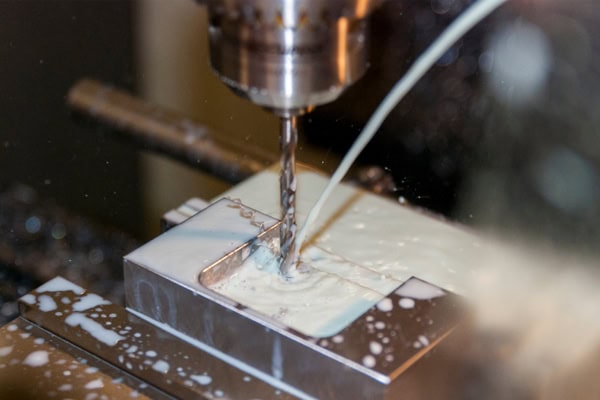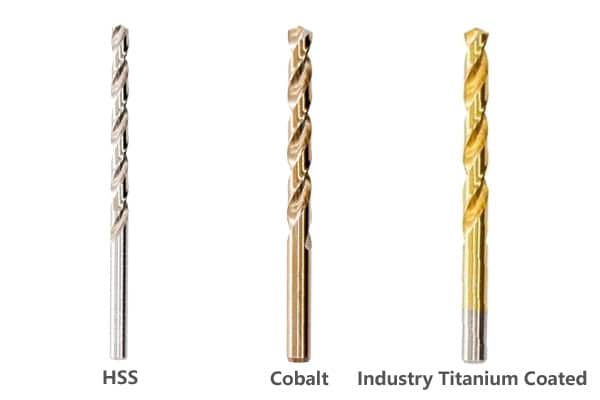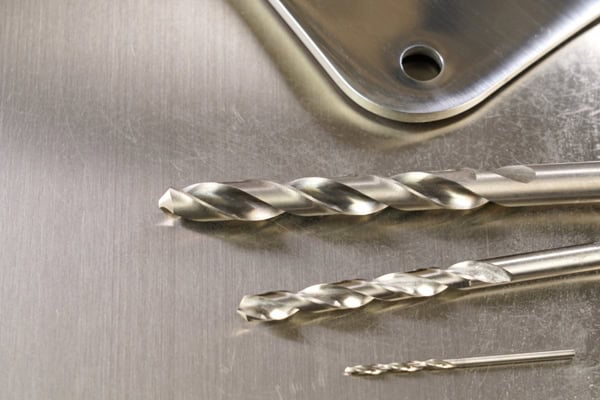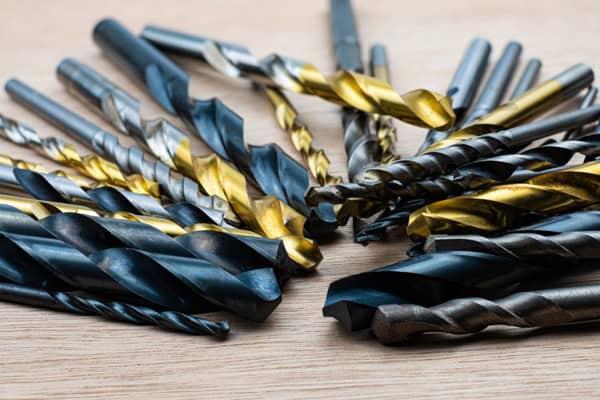Are you struggling to drill through stainless steel? It can be a frustrating task if you don’t have the right tools.
The best drill bits for stainless steel are typically made of cobalt or high-speed steel (HSS). Cobalt bits (M35 Co5% or M42 Co8%) are top-tier, but HSS6542 (M2) can work. These materials are harder and more heat-resistant, which is essential for cutting through the tough surface of stainless steel.

Choosing the right drill bit is only the first step. Keep reading to learn more about how to drill stainless steel effectively.
Can you Use an HSS Drill Bit for a Stainless Steel Sheet?
Ever tried using a regular drill bit on stainless steel? It probably didn’t go too well, did it?
Yes, you can use an HSS drill bit on a stainless steel sheet. HSS4241 or HSS4341 might struggle, but HSS6542 (M2) can do the job. However, for the best results, especially with thicker steel, cobalt drill bits are better because of their superior heat resistance.
HSS Grades Explained
HSS drill bits are a good starting point because they are versatile. HSS4241 and HSS4341 are okay for softer materials. However, when you step up to HSS6542 (M2)1, you get a bit more capability for drilling stainless steel2. The thing is, stainless steel is known for its hardness and heat resistance, which can wear down an HSS bit faster than other materials. That’s why technique is so important.
Technique Matters
Using a slow speed, applying consistent pressure, and using cutting fluid can really help to prolong the life of an HSS6542 bit when drilling stainless steel. For those who frequently work with stainless steel, investing in cobalt drill bits like M35 or M42 is still a worthwhile decision. Cobalt drill bits are specifically designed for harder metals and offer superior heat resistance and durability compared to standard HSS bits.
Cobalt is King (but Costs More)
They are less likely to dull or break, resulting in cleaner and more efficient drilling. Ultimately, the choice between HSS and Kobaltbohrer3 depends on how often you drill stainless steel and your budget. For occasional use, HSS6542 might be enough, but for tougher jobs, cobalt is the way to go.
| Feature | HSS Drill Bits (HSS6542/M2) | Cobalt Drill Bits (M35/M42) |
|---|---|---|
| Material | Hochgeschwindigkeitsstahl | High-Speed Steel with 5-8% Cobalt |
| Heat Resistance | Moderate | High |
| Haltbarkeit | Good | Excellent |
| Best Use Cases | Soft metals, thin stainless steel | Stainless steel, cast iron, tough alloys |
| Kosten | Lower | Higher |
Do I Need a Special Drill Bit for Stainless Steel?
I remember the first time I tried drilling stainless steel with a regular bit. It was a disaster! The bit dulled almost instantly.
Yes, you often need a special drill bit for stainless steel, especially if you want good results. Ordinary drill bits might not cut it because stainless steel is so hard. High-speed steel (HSS) like HSS6542 (M2) can work, but cobalt drill bits (M35 or M42) are specifically designed for stainless steel because they handle heat better.

Why Stainless Steel is Different
When drilling stainless steel4, the drill bit choice is super important. Stainless steel’s high strength and tendency to get harder when worked make it tough to drill. That’s why specialized drill bits5 are so helpful.
Cobalt Drill Bits: The Go-To Choice
Cobalt drill bits are a great choice. They have cobalt added to the high-speed steel, which makes them harder and more resistant to heat. This means they can handle the high temperatures from drilling, so they are less likely to get dull or break.
HSS Options and Coatings
Another option is titanium-coated HSS drill bits6. The coating makes the bit harder and helps reduce friction and heat. While they’re not as strong as cobalt bits, they can work for smaller jobs and make the drill bit last longer. Even HSS6542 can benefit from a titanium coating. The shape of the drill bit also matters. A 135-degree split point7 helps the bit start cutting into the stainless steel without slipping. Spiral grooves help remove metal chips and reduce heat, which makes the bit last longer and work better.
If you’re drilling stainless steel, it’s worth it to invest in good drill bits. They are stronger, handle heat better, and cut more efficiently, which means cleaner holes and less frustration.
| Feature | Benefit |
|---|---|
| Cobalt Material | High hardness and heat resistance for longer bit life |
| Titanbeschichtung | Reduced friction and heat buildup for smoother drilling |
| 135-Degree Split Point | Prevents bit from wandering and improves accuracy |
| Helical Flute Design | Improves chip evacuation and reduces heat for better performance |
What is the Best Way to Drill Stainless Steel?
Drilling stainless steel can seem hard, but if you do it right, it’s not too bad.
The best way to drill stainless steel is to go slow, use steady pressure, and use oil or cutting fluid to keep it cool. It also helps to start with a small hole to guide the drill bit and keep it from moving around.

Slow and Steady Wins the Race
Drilling stainless steel needs both the right way of doing things and the right tools. Speed is key. You need to drill slowly8 to keep the steel from getting too hot and hard. A drill press9 that lets you change the speed is great because you can set it just right.
Pressure and Lubrication
You also need to press down with the same amount of force all the time. Stainless steel needs more force than softer metals. If you press too hard, the bit gets hot. If you don’t press hard enough, it takes forever. Steady pressure helps the bit cut through the steel better.
Oil is super important to reduce heat. Cutting oil helps keep the bit cool and makes it last longer. Put some oil on the bit before you start and add more as you go. Starting with a small hole can also help you be more accurate and put less stress on the bit. The small hole guides the bigger bit and keeps it from wandering.
Securing the Workpiece
Lastly, make sure the stainless steel is held tight. Use clamps to keep it in place so you can drill straight and accurately.
| Technique | Benefit |
|---|---|
| Slow Speed | Prevents overheating and work hardening |
| Consistent Pressure | Ensures efficient cutting and prevents bit from overheating or dragging |
| Lubrication | Reduces friction and heat, extending drill bit life |
| Pilot Hole | Guides the drill bit and prevents wandering |
| Clamping | Secures the stainless steel in place for precise and accurate drilling |
Cobalt Drill Bits vs High-Speed Steel (HSS) drill bits
Choosing between cobalt and HSS drill bits can be confusing. Let’s break it down.
Cobalt drill bits (like M35 and M42) are stronger and handle heat better than HSS drill bits. This makes them great for drilling hard metals like stainless steel and cast iron. HSS bits, especially HSS6542 (M2), are cheaper and work well on softer stuff like wood and plastic. But for stainless steel, cobalt is better.

Cobalt: The Premium Option
When you’re picking drill bits, knowing the differences between cobalt and HSS is key for getting the best results. Both have their good and bad points, so they’re good for different things. Cobalt drill bits are basically HSS drill bits with 5-8% cobalt added. This makes them much harder and better at handling heat. They’re great for drilling tough stuff10 like stainless steel, cast iron, and titanium. They can handle high heat without getting dull, so they last longer and cut better.
HSS: The Budget-Friendly Choice
HSS drill bits are made from steel mixed with other metals like chromium and vanadium. They’re not as hard as cobalt bits, but they’re more flexible and cheaper. HSS bits are good for softer stuff like wood, plastic, and aluminum. Even HSS6542 (M2) is a step up from basic HSS, but it still doesn’t match cobalt for stainless steel.
Making the Right Choice
The choice really depends on what you’re drilling and how often you do it. For regular projects with wood, plastic, and softer metals, HSS drill bits are a good choice. But if you’re drilling tougher stuff like stainless steel or cast iron, cobalt drill bits are the way to go.
| Feature | HSS Drill Bits (HSS6542/M2) | Cobalt Drill Bits (M35/M42) |
|---|---|---|
| Material | Hochgeschwindigkeitsstahl | High-Speed Steel with 5-8% Cobalt |
| Härte | Moderate | High |
| Heat Resistance | Moderate | High |
| Haltbarkeit | Good | Excellent |
| Best Use Cases | Wood, plastic, thin stainless steel | Stainless steel, cast iron, titanium |
| Kosten | Lower | Higher |
Fazit
Choosing the right drill bit and using the proper technique can make drilling stainless steel a breeze. Remember to use a slow speed, apply consistent pressure, and keep the bit lubricated. For the best results on stainless steel, consider using cobalt drill bits like M35 or M42, but HSS6542 (M2) can work in some cases.
-
Learn about HSS6542 (M2) drill bits and their specific advantages for drilling stainless steel and other tough materials. ↩
-
Discover effective techniques for drilling stainless steel to enhance your skills and prolong the life of your drill bits. ↩
-
Discover the unique advantages of cobalt drill bits, especially for tough materials like stainless steel, to enhance your drilling efficiency. ↩
-
Learning effective techniques for drilling stainless steel can save time and prevent damage to your materials. ↩
-
Exploring specialized drill bits can help you select the right tools for drilling stainless steel effectively and safely. ↩
-
Explore the advantages of titanium-coated HSS drill bits for improved performance and longevity in your drilling tasks. ↩
-
Learn how a 135-degree split point enhances cutting efficiency and reduces slipping for better drilling results. ↩
-
Understanding the importance of drilling slowly can prevent overheating and improve the quality of your work, making this resource invaluable. ↩
-
Discover essential features of drill presses that enhance performance when working with stainless steel, helping you make an informed purchase. ↩
-
Discover what materials are classified as tough for drilling and the best tools to use for them. ↩